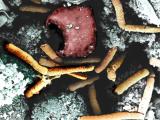Jul 17, 2006 (CIDRAP News) – A man is being treated for cutaneous (skin) anthrax and 36 farms are under quarantine because of livestock deaths in what has been called the largest anthrax outbreak in the history of the Canadian province of Saskatchewan.
The disease has killed 149 animals on the quarantined farms in northeastern Saskatchewan, according to today's update from the Canadian Food Inspection Agency (CFIA).
A man from the Melfort area, about 175 kilometers northeast of Saskatoon, contracted cutaneous anthrax, the least serious form of the disease, the Saskatchewan provincial government said in a Jul 14 news release. "The individual is being treated with antibiotics and is expected to make a full recovery," the statement said.
The release gave no information on how the man contracted the disease, but said cutaneous anthrax typically occurs when a person with a cut or abrasion comes into direct contact with anthrax spores on a sick or dead animal. In contrast, inhalational anthrax results from breathing in anthrax spores; it is usually fatal unless the patient receives prompt antibiotic treatment.
The CFIA said the outbreak does not pose "a significant human health threat." Cases in livestock rarely affect people, and no animals from the quarantined farms were sent to slaughter, the agency said. Anthrax does not spread from person to person.
The outbreak centers on the Melfort area, which rarely has any cases, according to CFIA veterinarian Dr. Sandra Stephens, who was quoted in a recent report in the Saskatoon Star Phoenix. The CFIA said 8,000 livestock have been vaccinated against anthrax in the area.
The disease emerged after heavy spring rains saturated the ground and brought anthrax spores to the surface, according to a Jul 12 report in the Toronto Globe and Mail. Animals contract anthrax by eating plants contaminated by the spores. The Star Phoenix story called the outbreak the largest in Saskatchewan history.
The outbreak has killed 123 cattle, 3 horses, 1 pig, 1 sheep, 13 bison, and 8 white-tailed deer, according to information from Stephens that was published on ProMED-mail, the online reporting service of the International Society for Infectious Diseases.
"We are vaccinating cattle on farms around the infected premises to create a buffer zone in an effort to break the cycle of infection," the CFIA said today. "Our monitoring of the situation indicates that the number of cases is declining." The agency said quarantines will be canceled 21 days after new cases abate.
The Star Phoenix said some private veterinarians in the area ran out of vaccine. Stephens said some vets didn't have the vaccine in stock because they weren't used to seeing cases.
Authorities recommend that animals killed by anthrax be burned or buried quickly to prevent other animals from being exposed to the carcasses. Ken Tegstrom, a Melfort area cattle farmer who was quoted in the Jul 12 Globe and Mail story, said so many cattle died the week of Jul 2 that farmers didn't have time to burn or bury them. Instead, the CFIA doused them in formaldehyde and covered them with tarpaulins for later disposal.
In the United States, some livestock cases of anthrax have been reported in Minnesota and North Dakota so far this year, but no large outbreaks. Last summer about 400 animals had died of the disease by early August in the Dakotas, Minnesota, and Texas.
Anthrax spores are found in soil in many parts of the world and can remain viable for decades.
See also:
Jul 14 Saskatchewan news release about cutaneous anthrax case
http://www.gov.sk.ca/news?newsId=1193e9c8-f864-4500-9111-e9d073c4cb55
Jul 6 Saskatchewan news release about conditions that increase anthrax risk
http://www.gov.sk.ca/news?newsId=507b8328-44bd-4239-8a65-00dd4f1544ed
CIDRAP overview of anthrax
http://www.cidrap.umn.edu/cidrap/content/bt/anthrax/biofacts/index.html

















